Effects of Palm Kernel (Elaeis guineensis) Cake on Sub-Bituminous Coal Briquette for Energy Generation
| Received 15 Mar, 2023 |
Accepted 22 Jul, 2023 |
Published 19 Aug, 2023 |
Background and Objective: Palm kernel cake is the waste released after the extraction of palm kernel oil from the seed. It is abundant and disposal of the waste has become a major concern. This work, therefore, seeks to produce an environmentally friendly bio-coal briquette from palm kernel (Elaeis guineensis) cake and measure their properties as an effective fuel. Materials and Methods: Briquettes of 100% of coal dust (C), biomass (PK) and a blend (1:1), for the combination (CPK) were produced. They were dried to a moisture content of 5-10% and ground to a particle size of 1 mm. Desulphurization, homogeneity and binding were done, using calcium hydroxide (Ca(OH)2), water and starch, respectively. Briquetting was done using a manual briquetting machine at 5 Mpa pressure for 2 hrs and sun-dried for 10 days. Proximate analyses, calorific value, combustion, emission profile and thermal degradation properties of the biomass, coal and blend were determined in line with ASTM D-3173. Results: The sample CPK had good combustion features because of their high thermal efficiency (28%), lower boiling time (43 min), burning rate (2.32 g min‾1) and firepower (782 watts). For the emissions as captured by Laboratory Emission Measuring Systems (LEMS), the blend CPK reduced the concentration of the CO (22 ppm) and CO2 (66 ppm) evolved during combustion. The particulate matter (PM) of the blend, though found to be higher than the permissible range in the atmosphere as stipulated by WHO-AAQS and NAAQS (150 µg m‾3), was reduced. The TGA/DTA analyses showed that all the samples were thermally stable. Conclusion: The overall result has shown that combining coal with biomass increased the combustion properties, reduced the level of gaseous emissions and improved the thermal degradation properties of the sub-bituminous coal.
| Copyright © 2023 Ofoefule et al. This is an open-access article distributed under the Creative Commons Attribution License, which permits unrestricted use, distribution, and reproduction in any medium, provided the original work is properly cited. |
INTRODUCTION
With the continuously growing population around the world, energy demand is becoming a critical challenge for the world’s energy leaders. The consumption of energy has become part of human daily life activities. There are different reasons for the search for alternative fuels that are technically feasible, eco-friendly, economically competitive and readily available. The first reason is the increasing demand for fossil fuels in all sectors of human life such as transportation, power generation, industrial processes and residential consumption1. The energy requirement increases steadily as the number of industries increases and the present power supply is unable to meet the energy demand. To minimize this energy shortfall, more efforts are put into research and development to tap alternative energy sources. Biomass is an alternative energy source. Briquetting or densification is a mechanical treatment to upgrade the loose biomass into a higher-density and uniform solid fuel via compaction. It has higher density and energy content and less moisture compared to its raw material2. Briquetting is the conversion of scattered agricultural residues/wastes into a useful product (biomass fuel) through the technology known as densification. The densification process supports the utilization of renewable sources and clean energy demand3. Coal can be blended with these agricultural wastes (biomass) to produce bio-coal briquettes. These briquettes ignite fast and burn efficiently, producing little or no smoke and are cheaper than coal briquettes.
The oil palm plant (Elaeis guinensis) produces a fruit with a nut inside the fruit. The fruit is boiled in water to extract the palm oil. After the oil extraction from the fruit, the nuts are broken for the palm kernels. The seed is the source of palm kernel oil (PKO) used extensively as food or animal feed4. The pulp left after oil is rendered from the kernel; forms the "palm kernel cake”. Palm kernel cakes, though used in feed production for ruminants are not fully utilized for that purpose as most of them find their way into the dustbin and pose environmental nuisance/hazard. If densified into a briquette, it would be put to better use, hence the choice of this biomass.
Onuegbu et al.5 researched the preparation of environmentally friendly bio-coal briquette from groundnut shell and maize cob biomass waste. The results showed that the blend with maize cob was better than that of the groundnut shell. Sarkar et al.6 reported a comparative assessment of the combustion performance for two types of binary blends viz: Coal-sawdust (SD) and coal-SD char using a Thermogravimetric analyzer (TGA) and a Drop Tube Furnace (DTF), based on which judicial selection of blends may be made possible. Their study showed that blends of either of the above fuels showed better performance in terms of major TGA-reactivity indices, ignition index and DTF-burn out efficiency when compared to coal-based performance (as benchmark). The activation energy for co-combustion in TGA showed a synergistic effect. Between the two options of blend types, ‘coal-SD char’ appeared to be superior to the coal-sawdust.
Razuan et al.7 studied the processing of pelletized palm kernel cake for fuel production. The focus of the research was on the effect of physical properties of tensile strength, density, pressure and binder effectiveness. Chansa et al.8 also carried out a Thermo-gravimetric study of the kinetic behaviour of biomass, coal and its blends during oxyfuel co-combustion. There is minimal work carried out using palm kernel cake for briquette production or its combination with coal. Again not much is seen in the available literature on thermal studies on briquettes from palm kernel cake. This work therefore, seeks to produce environmentally friendly bio-coal briquette from palm kernel (Elaeis guineensis) cake and sub-bituminous coal while studying their properties in terms of, combustion, emissions and thermal properties (both singly and in combination) to ascertain their effectiveness as veritable fuel for heating.
MATERIALS AND METHODS
Study area: The study was carried out in the Department of Pure and Industrial Chemistry in conjunction with the laboratory of the National Centre for Energy Research and Development all at the University of Nigeria, Nsukka, Enugu State, Nigeria from December, 2016 to July, 2017.
Collection of sample: The coal sample was collected from Onyeama mine in Enugu state Nigeria and identified at Nigerian Coal Corporation, Enugu, Nigeria. The biomass feedstock (palm kernel cake) was
collected locally around the Nsukka environs. Other materials used include, water, calcium hydroxide, starch, a briquette stove, a spatula and filter paper. Manual hydraulic briquetting machine with rectangular moulds (5 MPa pressure, fabricated by Scientific Equipment and Development Institute (SEDI) Enugu State, Nigeria), Thomas Willey Laboratory Mill Model ‘4, commercial locally fabricated grinding machine, electronic digital weighing balance (Ohaus, Adventurer, Model- AR3130, USA), Sieve of 1 mm in diameter, plastic bowl, solar drier, graduated measuring cylinder and trays. Analytical pieces of equipment include, a Laboratory Emission Monitoring System (LEMS), Oxygen Bomb Calorimeter (Model XRY-1A, Shangai China) and thermogravimetric analyser (TGA 4000 PerkinElmer).
Sample preparation: The coal sample and the biomass feedstock were sun-dried for 14 days using a solar drier to reduce their moisture content. The dried samples were then ground in a commercial locally fabricated electric milling machine (Thomas Willey Laboratory Mill Model ‘4’) to reduce their particle sizes to about 1mm making them ready for briquette production.
Production of the briquette samples: The briquettes were produced in the laboratory of the National Centre for Energy Research and Development, University of Nigeria, Nsukka, Enugu State in 2016. Briquettes of 100% of pure coal and palm kernel cake biomass were produced first. This was followed by binary combinations (i.e. biomass and coal). The process flow for the briquette production was shown in Fig. 1.
The summary of the weights of the different materials for the production of the briquettes was shown in Table 1.
| Table 1: | Summary of mixtures of the various weights of the materials for the briquettes preparation | |||
| Briquette samples |
Materials | Weight of materials (g) |
Weight of Ca(OH)2 (g) |
Volume of H2O (mL) |
Weight of starch (g) |
| C | Coal dust | 500 |
20 |
500 |
100 |
| PK | Palm kernel cake | 500 |
- |
350 |
100 |
| C+PK | Coal dust+Palm kernel cake | 250+250 |
20 |
400 |
100 |
| C: 100% Coal dust, PK: 100% Palm kernel cake and CPK: 50% Coal dust+50% Palm kernel cake | |||||
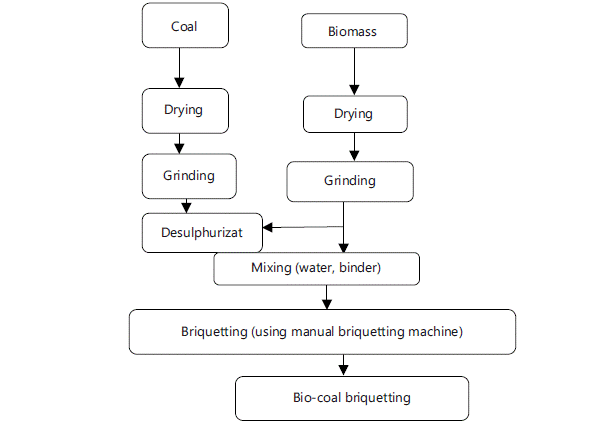
|
Physico-chemical composition of the samples: Moisture content, volatile matter content, ash content and fixed carbon of briquette samples were determined using Pyris manager software version 8.0 in the thermogravimetric data analyser TGA 4000 (PerkinElmer) in line with ASTM D-3173 specifications. The thermal degradation properties were also determined using the TGA. The calculated useful fuel was determined by extrapolating the difference between the starting weight (mg) of the briquettes and the final weight after degradation multiplied by 100% from the various TGA plots. Each briquette sample (100 mg) was loaded into TGA 4000 (PerkinElmer) and was analyzed in a nitrogen environment at a flow rate of 20 mL min–1, a pressure of 2.5 bars and a heating rate of 10°C min–1. The calorific value was determined using Oxygen Bomb Calorimeter (Model XRY-1A, Shangai China).
Combustion characteristics: This was done via a water boiling test (WBT) and was carried out to determine the combustion characteristics of the briquettes. It measured the time taken for each set of briquettes to boil an equal volume of water under similar conditions. The 100 g of each briquette sample was used to boil 1000 cm3 of water, using an aluminium pot (2 L capacity) and a domestic briquette stove (fabricated by the National center for Energy Research and Development, University of Nigeria, Nsukka). Other fuel properties of the briquettes including burning rate, thermal efficiency,- firepower and specific fuel consumption were determined.
Emissions characterisation: Laboratory Emissions Monitoring System (LEMS) was used to quantify emissions of pollutants from cooking stoves/fuels9. This collected, measured, and analyzed emissions of CO, CO2 and particulate matter (PM) emitted during combustion. The thermal stability of the briquettes was determined using TGA 4000 (PerkinElmer). The thermal responses of the samples were examined by subjecting them to a temperature of up to 850°C and the rate at which the samples degraded was noted from the DTA curve produced by the software, Pyris manager software version 8.0 on TGA 4000 (PerkinElmer).
RESULTS
The result of the physicochemical properties of the briquettes was shown in Table 2.
The single coal briquette had the highest calorific value of 23,471 kJ kg–1, the highest volatile matter of 70.17% and the lowest ash content and fixed carbon while the moisture content was equally low (1.66%). The single palm kernel cake briquette had a lower calorific value of 19, 544 kJ kg–1 and a much higher fixed carbon of 52.96%. The volatile matter was low while the ash content and moisture contents were low. The combination of coal and palm kernel cake CPK had an increased calorific value up from the CP. The fixed carbon was equally increased. The volatile matter had a minimal increase while the ash content and the moisture contents were further reduced from the values of the single briquettes.
The results of the combustion parameters of the various briquettes were shown in Table 3.
The single coal briquette had a higher burning rate of 3.36 g min–1, long cooking time (50 min), high firepower (1240 watts) and specific fuel consumption (173.24 g L–1) but low thermal efficiency (11%). The palm kernel cake briquette had a lower burning rate (2.7 g min–1), very short cooking time (25 min), low firepower (819 watts) and high specific fuel consumption (172.71 g L–1). The interaction of these parameters gave rise to very high thermal efficiency (36%). The combination CPK had the lowest burning rate (2.32 g min–1), firepower (782 watts) and specific fuel consumption (115.25 g L–1). The cooking time was long (43 min) though slightly shorter than that of the single coal briquette. The thermal efficiency (28%) was an improvement on that of the coal briquette but lower than the single PK cake briquette.
| Table 2: | Physico-chemical composition of fuel briquettes | |||
| Fuel | Moisture |
Ash content |
Volatile matter |
Fixed carbon |
Calorific value |
| sample | content (%) |
(%) |
(%) |
(%) |
(kJ kg–1) |
| C | 1.66 |
1.19 |
70.17 |
27.03 |
23,471 |
| PK | 4.25 |
2.5 |
40.73 |
52.96 |
19,544 |
| CPK | 0.38 |
2.38 |
41.07 |
56.7 |
21,508 |
| C: 100% Coal dust, PK: 100% Palm kernel cake, CPK: 50% Coal dust+50% Palm kernel cake | |||||
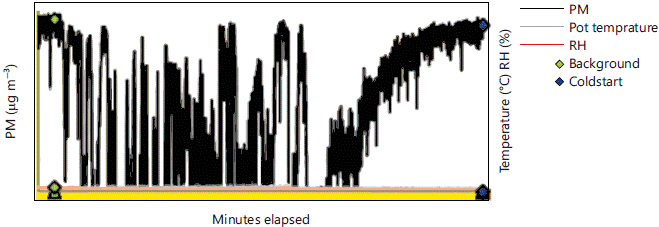
|
| Table 3: | Combustion parameters of the various briquettes | |||
| Fuel sample | Burning rate (g min–1) |
Time required to boil water (min) |
Specific fuel consumption (g L–1) |
Firepower (watts) |
Thermal efficiency (%) |
| C | 3.36 |
50 |
173.24 |
1240 |
11 |
| PK | 2.7 |
25 |
172.71 |
819 |
36 |
| CPK | 2.32 |
43 |
115.25 |
782 |
28 |
| Table 4: | Emission profile of PM, CO and CO2 of the various briquettes compared to WHO-AAQS/NAAQ | |||
| Sample | PM (μg m–3) |
CO2 (ppm) |
CO (ppm) |
| C | 3051 |
99 |
33 |
| PK | 1078 |
54 |
18 |
| CPK | 412 |
66 |
22 |
| WHO-AAQS | 150 |
600 |
35 |
| NAAQS | 250 |
- |
- |
| WHO-AAQS: World Health Organization-Ambient Air Quality Standards, NAAQS: National Ambient Air Quality Standards, PM: Particulate matter, CO2: Carbon dioxide and CO: Carbon monoxide | |||
The results of the emission profiles of the briquettes and the standards with which they were compared were presented in Table 4.
The single coal briquette had a very high particulate matter of 3,051 μg m–3. The CO2 and CO contents were low and good. The palm kernel cake had an equally high particulate matter and very low and good CO2 and CO contents. The combination- PKO had highly reduced particulate matter but CO2 and CO were slightly higher than the single PK briquette.
The plot of the particulate matter for the single coal briquette C was shown in Fig. 2. The values in Table 4 were extrapolated from the plot by the system as recorded.
The plot of the CO2 and CO for the single coal briquette was shown in Fig. 3. The values in Table 4 were extrapolated from the plot by the system as recorded.
The plot of the particulate matter for the single PK briquette is shown in Fig. 4. The values in Table 4 were extrapolated from the plot by the system as recorded.

|
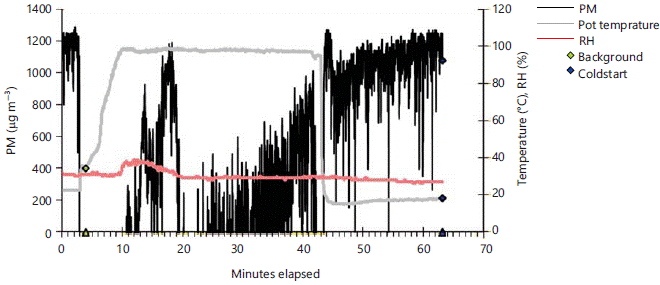
|
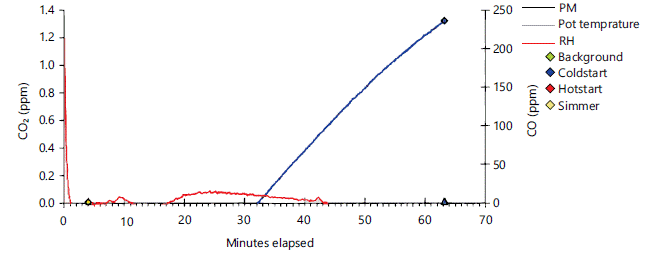
|
The plot of the CO2 and CO for the single PK briquette was shown in Fig. 5. The values in Table 4 were extrapolated from the plot by the system as recorded.
The plot of the particulate matter for the single CPK briquette was shown in Fig. 6. The values in Table 4 were extrapolated from the plot by the system as recorded.
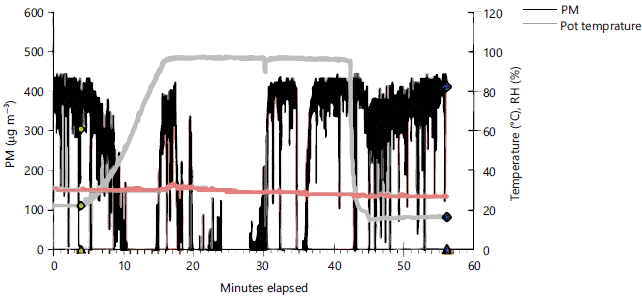
|
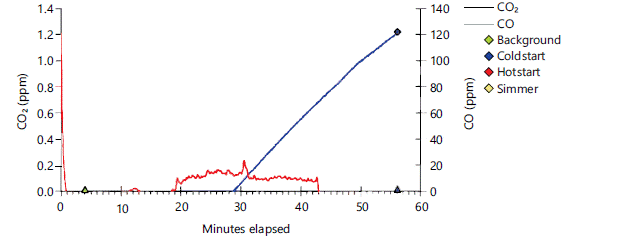
|

|
The plot of the CO2 and CO for the single CPK briquette was shown in Fig. 7. The values in Table 4 were extrapolated from the plot by the system as recorded.
The result of the thermal properties of the Coal briquette was shown in Table 5 and the plot in Fig. 8.
The degradation of the single coal briquette started at 256.30°C and ended at 466.90°C. It had a single sharp peak at 302.22°C. The calculated useful fuel (which is the amount of degradable portion of the feedstock yielding energy) was 80%. The degradation of the palm kernel cake briquette had two degradation phases at 227.42 to 377.56°C with a sharp peak at 350.15°C and from 377.56 to 420.45°C with another sharp peak at 420.45°C. The calculated useful fuel was also 80%. The degradation of the combination of coal and palm kernel cake briquette (CPK) again had two phases at 236.50 to 394.71°C with a broad peak at 346.90 and 394.71 to 550°C with another broad peak at 447.75°C. The calculated useful fuel was also 80%.

|
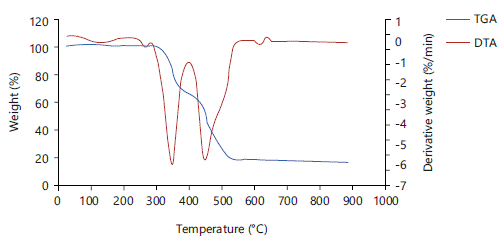
|
| Table 5: | Degradation temperature ranges and Peak temperatures from the TGA/DTA analyses for the briquettes | |||
| Fuel samples | Degradation temperature (°C) |
Peak temperature (°C) |
Calculated useful fuel (%) |
| C | 256.30-466.90 |
302.22 |
80 |
| PK | 227.42-377.56 |
350.15 |
80 |
377.56-420.52 |
420.45 |
- |
|
| CPK | 236.50-394.71 |
346.9 |
- |
394.71-550. 46 |
447.75 |
80 |
|
| C: 100% Coal dust, PK: 100% Palm kernel cake and CPK: 50% Coal dust+50% Palm kernel cake | |||
This plot shows one broad peak of degradation at 256.30-466.90◦C.
The plot of the thermal degradation of the palm kernel cake briquette was shown in Fig. 9.
This shows the two sharp peaks of the degradation at 227.42-377.56 and 377.56-420.52°C. The plot of the thermal degradation of the palm kernel cake briquette was shown in Fig. 10. This shows the two broad peaks of degradation at 236.50-394.71 and 394.71-550.46°C.
DISCUSSION
The physico-chemical properties of the single coal briquette indicate that the moisture content of the coal briquette was very low (1.66%). The lower the moisture contents of a briquette, the higher the calorific value10. The moisture content of more than 15% produces poor and weak briquettes11. Very low moisture value in briquettes is not very good for storage purposes since very low moisture makes the briquette very brittle and subject to poor durability12. However, care can be taken to ensure that the briquette is not left too long to dry after production before usage. This result was low when compared with that of Onuegbu et al.5 (Maize cob-12.2%, groundnut shell-10.30, coal-6.10%), Ajimotokan et al.13 (Pine needle-6.8%, Czassava peel-7.8%, Charcoal particles-3.0%). It however compared well with Ofoefule et al.9, probably due to the equipment utilized for determining the proximate analysis which was TGA, 4000 (PerkinElmer). The volatile matter content of the coal dust briquette was the highest when compared to the other briquettes. This showed that the briquette would ignite rapidly and also increase in flame length proportionately14. Coal briquettes usually volatilize and burn as gas in the stove as a result of high volatile matter content. However, it was lower than that of Sub-bituminous coal (23%) reported by Onuegbu et al.5. The ash content was very low. For optimal thermal utilization, fuels with low ash content are better than fuels with high ash content. Lower ash content is valuable, while excess ash causes slagging during burning, the ash is capable of blocking air from penetrating the stove, thereby retarding the burning rate of such briquette unless the stove is often shaken to clear the ash during cooking15. This ash content was much lower than the value obtained from briquettes reported by other researchers16-18. The fixed carbon of the coal briquette was low. The fixed carbon of fuel gives an idea of its calorific value as well as acts as the major producer of heat during combustion after the volatiles have been removed. It was lower than that for sub-bituminous coal reported by Onuegbu et al.5. The calorific value of the coal briquette was high (Table 3). This heating value of the coal briquette was the highest when compared to the other variants19. Owing to the high calorific value of coal briquette, the firepower during combustion was also high. This result is in consonance with the results obtained by Ajimotokan et al.13 and Onukak et al.20 etc. Even though the firepower and burning rate were high, the time taken to boil 1 L of water was quite long. This led to low thermal efficiency when compared to the other briquettes as shown in Table 3. When compared with the performance of Pine needle dust and its combination with coal, it was poorer since the Pine needle gave a higher thermal efficiency of 33%9. The concentration of the harmful emissions given off during combustion as captured by the LEMS showed that coal briquette emitted the highest concentration of particulate matter (Table 4) when compared to the other variants. This was higher than the World Health Organization Ambient Air Quality Standard (WHO-AAQS) and Nigerian Ambient Air Quality Standard (NAAQS)9. The emission profile of the particulate matter for the briquette sample C indicates that the high particulate matter could be a result of the high volatile components of the coal briquette as well as the high deposition of particles from the material composition of the raw coal sample. Again, the concentration of carbon dioxide (CO2) and carbon monoxide (CO) emitted were high when compared with the single palm kernel cake briquette. However, when compared to WHO-AAQS and NAAQS standards, they were within the permissible range for one hour in the atmosphere. The TGA/DTA plot for the coal dust briquette as shown in Table 5 indicates that at 256.3°C, the mass of the coal briquette started degrading until at 466.95°C when all the useful fuel had been effectively combusted. The loss in mass was a result of the release of some volatile matters, (CO, CO2-), water etc.16. Therefore, a further increase in temperature did not have any effect on the mass of the coal left in the furnace after the temperature of 466.95°C. It shows that what was left in the crucible was the non-combustible matter. Therefore, the percentage of useful fuel for the coal briquette was 80% while the remaining 20% was supposed to be non-combustible materials and ash. This result compared well with the result obtained from the TGA/DTG profile of Empty fruit bunch (EFB) briquette (70.55%) reported by Nyakuma et al.17 and that obtained from Cashew nutshell (77%) reported by Tsamba et al.18. Again, the TGA plot, indicates that the coal briquette lost its stability at 466.95°C. The DTA plot again showed that during combustion, the presence of one sharp peak was an indication that most of the volatile components were driven off at that degradation temperature (365.31°C).
The moisture content of the palm kernel cake briquette was also low (4.25 %), though slightly higher than that of the coal briquette and that of other biomass materials5,13. It was low when compared to other biomass like rice straw (12.2%), Wheat straw (14.6%) and Groundnut husk/shell (7.8%) as reported by Saeed et al.12. The low moisture content of the briquette indicates a higher calorific value and good burning characteristics19. The volatile content of the palm kernel cake briquette was low (40.73%) when compared with coal and therefore was not expected to have much effect on the combustion. Ash content was equally low (2.50%) which makes it a very good fuel for combustion. This is the percentage of non-combustible components of the palm kernel cake briquette. It was low when compared to some biomass like rice straw (11.25%), Barley straw (4.3%) and Cornstalk (10.0%)12. For optimal thermal utilization, fuels with low ash content are better than those with high ash content. The fixed carbon for PK was high (Table 2). This indicates that palm kernel cake will be a suitable feedstock for charcoal production for other thermal purposes. The calorific value (19,544 kJ kg–1) was lower than that of coal. Even though, lower than coal, this value was sufficiently okay to generate the needed heat for household uses. This value compared well with other heating values of many biomass briquettes such as Tannery solid briquette (9.08-14.57 MJ kg–1) 20, Saw dust and Sorghum hybrid briquette21, Corn corb briquette (17.25 MJ kg–1)12, waste paper and Groundnut shell (19.51-19.92 MJ kg–1)22. Though the firepower (819 watts) was lower than the coal variant, it had a shorter boiling time leading to higher thermal efficiency (36%). This shows that though the palm kernel cake had lower volatile matter content (40.73%) and firepower, its conversion to heat (exhibited by the thermal efficiency) was very high. This shows good combustion characteristics. The concentration of harmful emissions showed a lower particulate matter (1078 μm–3). This was higher than that of CPK but lower than the value for coal dust briquette. When compared to the WHO-AAQS and NAAQS, it exceeded the standard permissible in the atmosphere on exposure for 1 hr. The high particulate matter could be a result of the enclosed environment where the analysis was carried out. Again, the concentration of carbon dioxide (CO2) and carbon monoxide (CO) emitted were very low. These were the lowest when compared to the other briquettes and when compared to WHO-AAQS and NAAQS were within the permissible range for 1 hr in the atmosphere. Therefore, briquetting of palm kernel cake alone showed good combustion characteristics and low emissions of harmful substances into the atmosphere. For the thermal degradation profile for PK, the weight loss became effective and started degrading from 227.42 to 377.56°C while the second degradation started from 377.56 to 420.45°C. It was observed that the sample had two degradation peak temperatures at 340.15 and 420.45°C (Table 5). This implies that palm kernel cake briquette released most of its volatile components at those two different temperature ranges. These two peaks could be a result of the composition of the biomass containing cellulose and hemicelluloses which degrade at different temperatures. The briquette stopped degrading at 420.45°C as a further increase in the temperature did not have any effect on the mass of the sample. Again, it could also be deduced that the briquette lost its stability at 420.45°C indicating that coal had higher thermal stability than the palm kernel cake briquette. The useful fuel in the sample was calculated to be 80% while the remaining 20% were supposed to be non-combustible materials.
From Table 2, the combination of coal and palm kernel briquette CPK had a moisture content that was the lowest when compared to others (0.38%). This result only compares with that obtained from Tannery solid wastes20. This suggested a higher heating value and good burning characteristics. Again, this value is not very good for storage purposes since very low moisture makes the briquette very brittle and subject to breakage during transportation and storage11, however, care can be taken to ensure that the briquette is not left too long to dry after production before usage. Its volatile matter content was marginally increased by the combination. It had low ash content (2.38%) which is very good for fuel purposes. The fixed carbon of the briquette was high (56.70%). This was the highest when compared to the other variants and indicates that the combination will be a suitable feedstock for charcoal production and other thermal applications. The calorific value for this sample CPK was greatly improved by the
combination of coal and palm kernel cake (21,508 kJ kg–1). It shows that it is good enough for heat production for use in homes and industries. It also compared well with the result of the heating values of Tannery solid briquette (9.08-14.57 MJ kg–1)20, Saw dust and Sorghum hybrid briquette21, Corn cob briquette (17.25 MJ kg–1)12, waste paper and Groundnut shell (19.51-19.92 MJ kg–1)22. Combustion of the blended briquette gave a moderate burning rate (2.32 g min–1) and reduced the firepower (782 watts) when compared to coal alone while the thermal efficiency was lower than that of palm kernel cake alone but higher than that of coal. The time it took to boil water was longer than the single palm kernel cake briquette but shorter than that of the coal dust briquette. Therefore, blending the biomass (palm kernel cake) with coal reduced the burning time for coal briquette. The concentration of the particulate matter was shown to be the least when compared to other variants. Therefore, blending palm kernel cake with coal dust reduced the concentration of particulate matter given off during combustion. When compared to the WHO-AAQS and NAAQS, the concentration slightly exceeded the permissible standard in the atmosphere on exposure for 1 hr. Figure 6 shows the emission profile of the particulate matter for the briquette sample CPK. The emission of CO and CO2 were very low (22 and 66 ppm, respectively). When compared to the WHO-AAQS and NAAQS, they were far lower than the permissible standard in the atmosphere on exposure for 1 hr. Figure 7 shows the emission plot of CO and CO2. For the thermal degradation profile as shown in Table 5, the first degradation started at a temperature of 236.5 to 394.71°C while the second degradation started from 394.71 to 550.46°C. After this temperature, a further increase in the temperature did not have any effect on the mass of the briquette. This shows that the briquette lost all its useful fuel components at those temperature ranges. It was observed that blending coal with palm kernel cake increased the stability of the briquette during combustion. The two sharp peaks in the DTA curve (Fig. 10) indicated two major degradation temperature peaks at which most of the volatiles were driven off, both from the coal component and the palm kernel component. The percentage of useful fuel calculated was 80% while the remaining 20% could be non-combustible materials. The study was undertaken with a single-pressure hydraulic briquetting machine. It is recommended that future studies may look into multi-pressure briquetting machines to enable studies on the effect of briquetting pressure on the briquette quality. The Laboratory Emissions monitoring system (LEMS) needs to have more gas detection functions for SOx and NOx. Researchers using LEMS have had to incorporate gas analyzers as additional analytical tools in most recent studies on briquette production but it would be better if it was incorporated with the LEMS. Again, International non-governmental agencies (NGOs) are encouraged to fund the research for briquette production to assist the third-world countries who need it most.
CONCLUSION
This study revealed the strengths and deficiencies of the individual coal and palm kernel briquettes while showing the synergy in operation in combining them in terms of the combustion characteristics, emission profiles and thermal degradation/stability profile. The combination of the two improved the combustion/emission, thermal stability and degradation properties giving overall better properties when compared with using any of the single materials alone.
SIGNIFICANCE STATEMENT
The work utilized abundant waste in the country of focus which needs an outlet for usage. The technology, suited for rural and less developed areas is cheap and affordable. The project utilized a computerized system (Laboratory Emission and Monitoring System LEMS) for analyzing the combustion and emission studies which are novel to the area of study that has hitherto used manual systems. This gives real-time values for data obtained. Again, the study delved into thermal studies which are novel to the area of study and highlights the nature and behaviour of the feedstocks (material science) that gives important information to would-be investors in the technology.
REFERENCES
- Talebian-Kiakalaieh, A., N.A.S. Amin and H. Mazaheri, 2013. A review on novel processes of biodiesel production from waste cooking oil. Appl. Energy, 104: 683-710.
- Nasrin, A.B., A.N. Ma, Y.M. Choo, S. Mohamad, M.H. Rohaya, A. Azali and Z. Zainal, 2008. Oil palm biomass as potential substitution raw materials for commercial biomass briquettes production. Am. J. Appl. Sci., 5: 179-183.
- Vaish, S., N.K. Sharma and G. Kaur, 2022. A review on various types of densification/briquetting technologies of biomass residues. IOP Conf. Ser.: Mater. Sci. Eng., 1228: 012019.
- Paulin, Y.A. and K.A. Irène, 2019. Physico-chemical characterization of palm kernel oil extracted from the seeds of two varieties of oil palm (Elaeis guineensis Jacq.) for possible use in feed or food. Eur. J. Nutr. Food Saf., 9: 341-353.
- Onuegbu, T.U., N.O. Ilochi, I.M. Ogbu, F.O. Obumselu and I. Okafor, 2012. Preparation of environmental friendly bio-coal briquette from groundnut shell and maize cob biomass waste: comparative effects of ignition time and water boiling studies. Curr. Res. Chem., 4: 110-118.
- Sarkar, P., S.G. Sahu, A. Mukherjee, M. Kumar, A.K. Adak, N. Chakraborty and S. Biswas, 2014. Co-combustion studies for potential application of sawdust or its low temperature char as co-fuel with coal. Appl. Therm. Eng., 63: 616-623.
- Razuan, R., K.N. Finney, Q. Chen, V.N. Sharifi and J. Swithenbank, 2011. Pelletised fuel production from palm kernel cake. Fuel Process. Technol., 92: 609-615.
- Chansa, O., Z. Luo and C. Yu, 2020. Study of the kinetic behaviour of biomass and coal during oxyfuel co-combustion. Chin. J. Chem. Eng., 28: 1796-1804.
- Ofoefule, A.U., J.C. Igweagwu, M.N. Ugwu, C.D. Mgbadike, C. Esonye, 2019. Effects of pine needle (Pinus pinaster) dust on the performance characteristics of sub-bituminous coal briquette for energy generation. J. Phys. Chem. Sci., 7.
- Ríos-Badrán, I.M., I. Luzardo-Ocampo, J.F. García-Trejo, J. Santos-Cruz and C. Gutiérrez-Antonio, 2020. Production and characterization of fuel pellets from rice husk and wheat straw. Renewable Energy, 145: 500-507.
- Kaliyan, N. and R.V. Morey, 2009. Factors affecting strength and durability of densified biomass products. Biomass Bioenergy, 33: 337-359.
- Saeed, A.A.H., N.Y. Harun, M.R. Bilad, M.T. Afzal and A.M. Parvez et al., 2021. Moisture content impact on properties of briquette produced from rice husk waste. Sustainability, 13: 3069.
- Ajimotokan, H.A., A.O. Ehindero, K.S. Ajao, A.A. Adeleke, P.P. Ikubanni and Y.L. Shuaib-Babata, 2019. Combustion characteristics of fuel briquettes made from charcoal particles and sawdust agglomerates. Sci. Afr., 6: e00202.
- van Loo, S. and J. Koppejan, 2008. The Handbook of Biomass Combustion and Co-Firing. Earthscan, London, UK., ISBN: 9781844072491, Pages: 442.
- Tamilvanan, A., 2013. Preparation of biomass briquettes using various agro-residues and waste papers. J. Biofuels, 4: 47-55.
- Garzón, E., C. Arce, A.J. Callejón-Ferre, J.M. Pérez-Falcón and P.J. Sánchez-Soto, 2022. Thermal behaviour of the different parts of almond shells as waste biomass. J. Therm. Anal. Calorim., 147: 5023-5035.
- Nyakuma, B.B., A. Johari, A. Ahmad and T.A.T. Abdullah, 2014. Thermogravimetric analysis of the fuel properties of empty fruit bunch briquettes. J. Teknologi, 67: 79-82.
- Tsamba, A.J., W. Yang and W. Blasiak, 2006. Pyrolysis characteristics and global kinetics of coconut and cashew nut shells. Fuel Process. Technol., 87: 523-530.
- Kpalo, S.Y. and M.F. Zainuddin, 2020. Briquettes from agricultural residues; An alternative clean and sustainable fuel for domestic cooking in Nasarawa State, Nigeria. Energy Power, 10: 40-47.
- Onukak, I.E., I.A. Mohammed-Dabo, A.O. Ameh, S.I.R. Okoduwa and O.O. Fasanya, 2017. Production and characterization of biomass briquettes from tannery solid waste. Recycling, 2: 17.
- Imoisili, P.E., K.O. Ukoba, B.E.A. Daniel and M.C. Ibegbulam, 2014. Production and characterization of hybrid briquette from biomass. Curr. J. Appl. Sci. Technol., 4: 1534-1539.
- Oyelaran, O.A., B.O. Bolaji, M.A. Waheed and M.F. Adekunle, 2015. Performance evaluation of the effect of waste paper on groundnut shell briquette. Int. J. Renewable Energy Dev., 4: 95-101.
How to Cite this paper?
APA-7 Style
Ofoefule,
A.U., Ugwu,
M.N., Igweagwu,
J.C., Mgbadike,
C.D. (2023). Effects of Palm Kernel (Elaeis guineensis) Cake on Sub-Bituminous Coal Briquette for Energy Generation. Trends in Applied Sciences Research, 18(1), 118-130. https://doi.org/10.3923/tasr.2023.118.130
ACS Style
Ofoefule,
A.U.; Ugwu,
M.N.; Igweagwu,
J.C.; Mgbadike,
C.D. Effects of Palm Kernel (Elaeis guineensis) Cake on Sub-Bituminous Coal Briquette for Energy Generation. Trends Appl. Sci. Res 2023, 18, 118-130. https://doi.org/10.3923/tasr.2023.118.130
AMA Style
Ofoefule
AU, Ugwu
MN, Igweagwu
JC, Mgbadike
CD. Effects of Palm Kernel (Elaeis guineensis) Cake on Sub-Bituminous Coal Briquette for Energy Generation. Trends in Applied Sciences Research. 2023; 18(1): 118-130. https://doi.org/10.3923/tasr.2023.118.130
Chicago/Turabian Style
Ofoefule, Akuzuo, Uwaoma, Matthias Nnadozie Ugwu, Jude Chibuike Igweagwu, and Chukwunalu Destiny Mgbadike.
2023. "Effects of Palm Kernel (Elaeis guineensis) Cake on Sub-Bituminous Coal Briquette for Energy Generation" Trends in Applied Sciences Research 18, no. 1: 118-130. https://doi.org/10.3923/tasr.2023.118.130

This work is licensed under a Creative Commons Attribution 4.0 International License.



